Be Your Customers’ Ritual: Consistent Engagement Results in 90% Audience Retention after One Month
Published on November 05, 2015/Last edited on November 05, 2015/7 min read


Todd Grennan
Content Production Principal, Content Marketing at BrazeRituals support healthy relationships. Whether or not you regularly make the time to have coffee with a friend will affect if you stay close over time. And that same principle holds true when it comes to relationships with your customers. New research carried out by Appboy* (that’s us!) has found that levels of customer engagement have a direct correlation with levels of customer retention. More specifically:
- Only 55% of individuals who use an app in the first week after download will be retained (i.e. will show further activity over the next three months)
- 90% of the people who engage weekly for the first month after download are retained, compared to only 23% of people who don’t engage in the second, third and fourth week
- 82% of customers who engage in week two are retained, but customers who don’t engage in week two have to engage in both week three and four to reach almost the same level of retention.
- When we looked at the data by OS and app vertical, the absolute retention numbers change, but the overall pattern remains directionally consistent
Interested in learning more about the impact of consistent engagement on retention and how it grows and shifts over time? Well, read on!
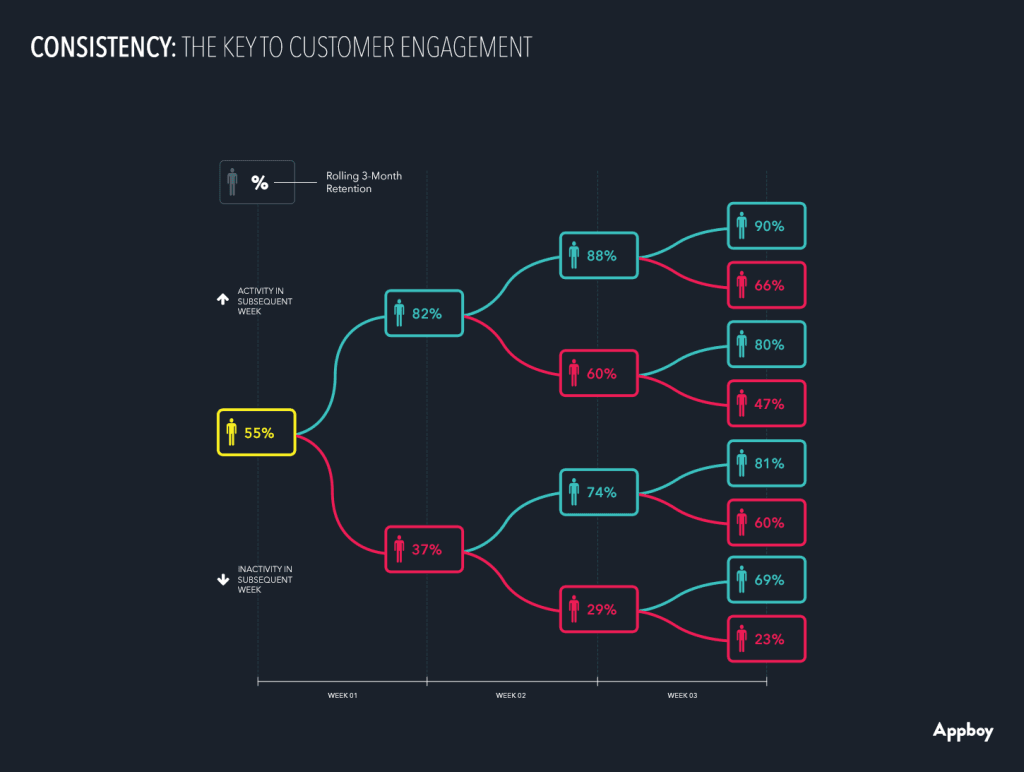
Early engagement really matters
When someone downloads an app and opens it for the first time, the odds that they return to the app in the next three months aren’t great – only 55%.
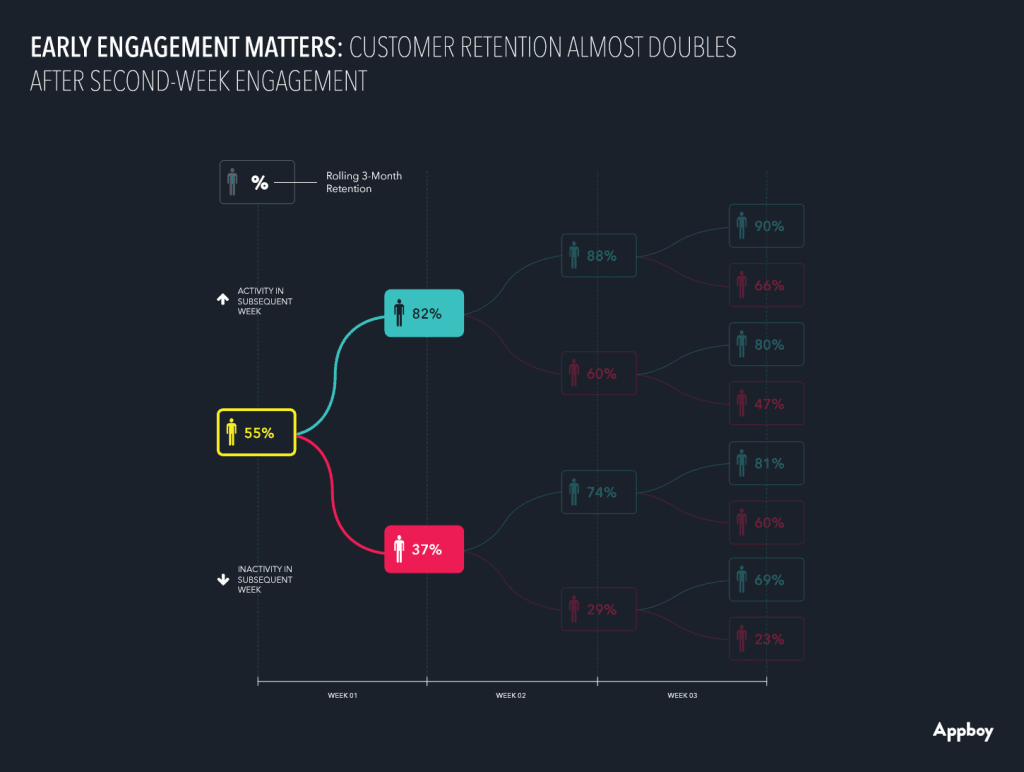
Brands who see their new customers come back for a second week increase their retention rate to 82%; those that don’t see it fall to 37%. This difference in retention can have a significant impact on an app’s long-term success and can drive up (or drive down) the total cost of acquiring a loyal customer, which is already as high as $14-27 each.
Brands that welcome new customers to their apps with robust, well-structured onboarding experiences are going to be better positioned to communicate the value that their apps can provide, making continued use more appealing for their audience. And making sure that those customers finish onboarding is key – brands that encourage customers to complete onboarding using both a push notification and a message in a second channel (like email or in-app messages) increase their app’s two-month retention by 130%, compared to brands that sent no messages.
Retention trends deepen week by week
When it comes to retention, consistent customer engagement has a major impact that grows over time. That means that new customers who engage with an app week after week for the first month after download have the highest levels of retention, with 90% of them showing additional activity over the next three months. On the other hand, lack of engagement builds the same way, too: only 23% of customers who fail to engage with an app during weeks two through four will be retained.
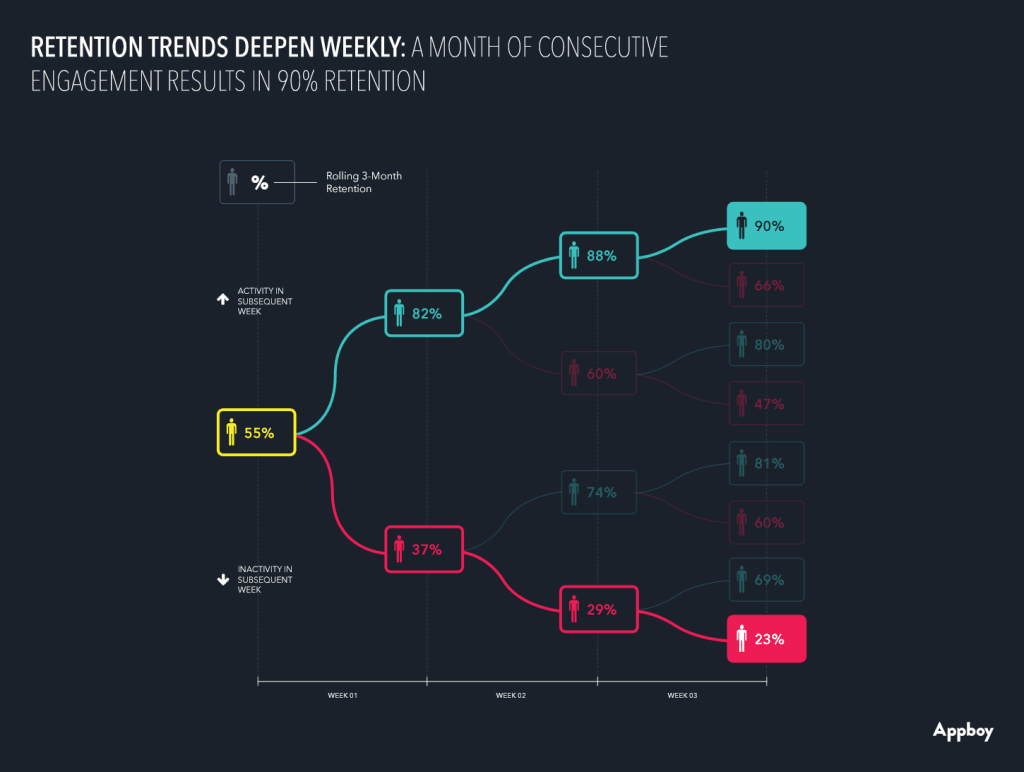
However, the retention benefits of consistent engagement level off over time. Customers who engage with an app for the first three consecutive weeks after download have a retention rate of 88%, only two percentage points below the rate seen with customers who engage for four consecutive weeks.
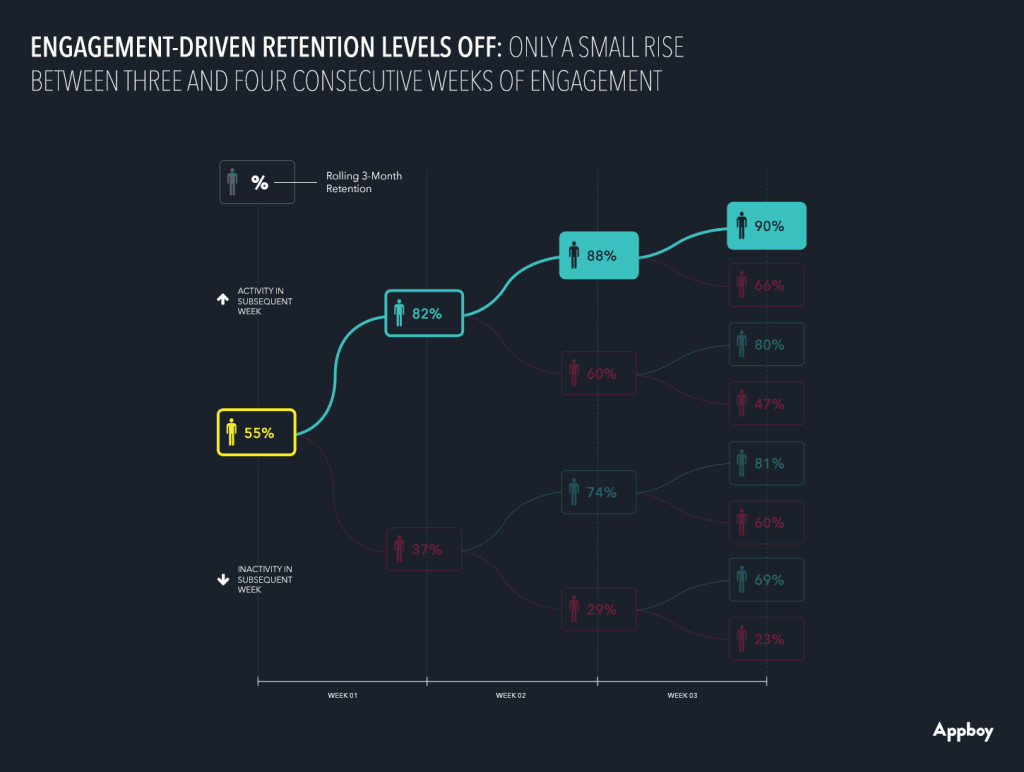
The negative impact that lack of customer of engagement has on retention levels off, too. While 29% of customers who don’t engage with an app in weeks two and three are retained, a third consecutive week without engagement only drops their retention rate to 23%.
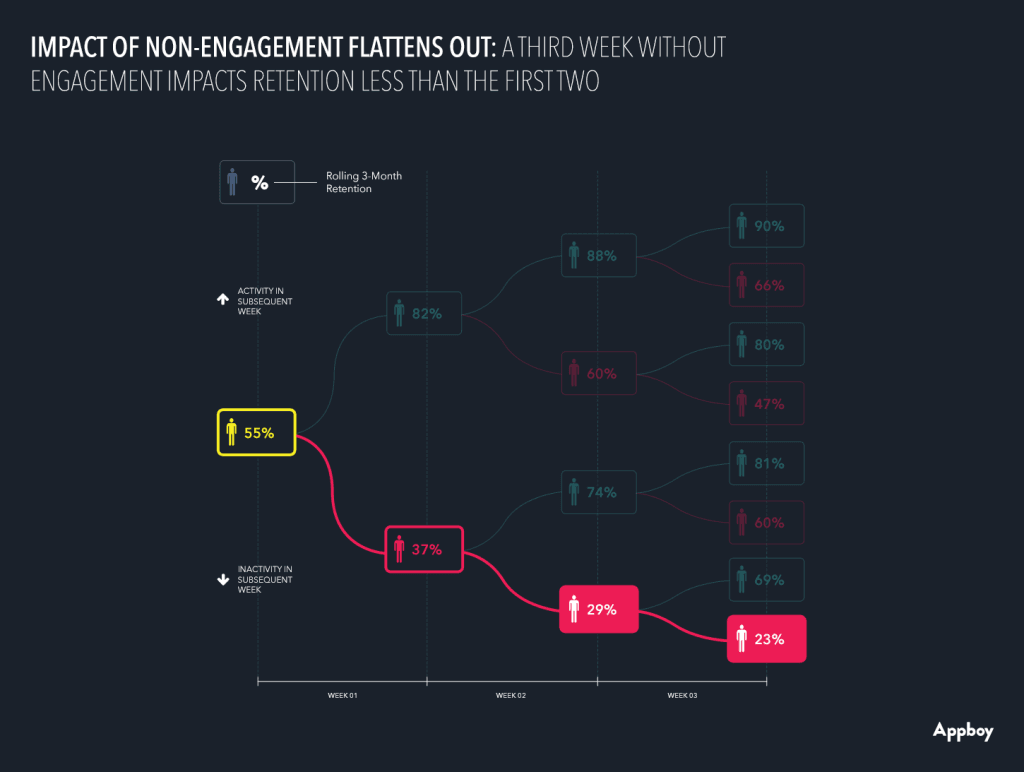
App usage is like any other ritual. The people who consistently play a particular gaming app during their morning commute or check a news app before going to bed are establishing a relationship with those apps that can last for a long time. That means brands that successfully encourage their audience to be consistent about their usage have an advantage when it comes to long-term engagement and retention.
…And every week matters
After a while, consistent customer engagement stops leading to major jumps in retention (in part because there’s only so much higher than 90% that retention can really go). At that point, continued engagement is linked not to retention gains, but to preventing significant losses – after all, holding onto a customer can be just as valuable as acquiring a new one.
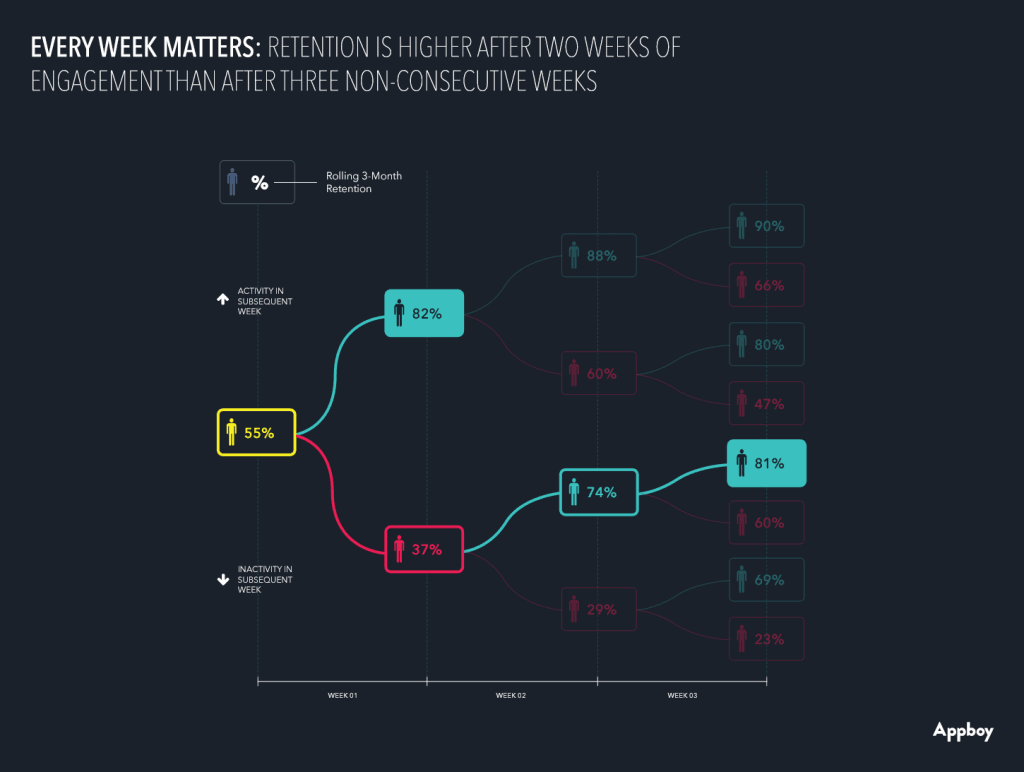
Customers who engage with an app during week two have a retention rate of 82%. But customers who don’t engage during week two need to engage during both week three and four to get their retention rate up to 81%.
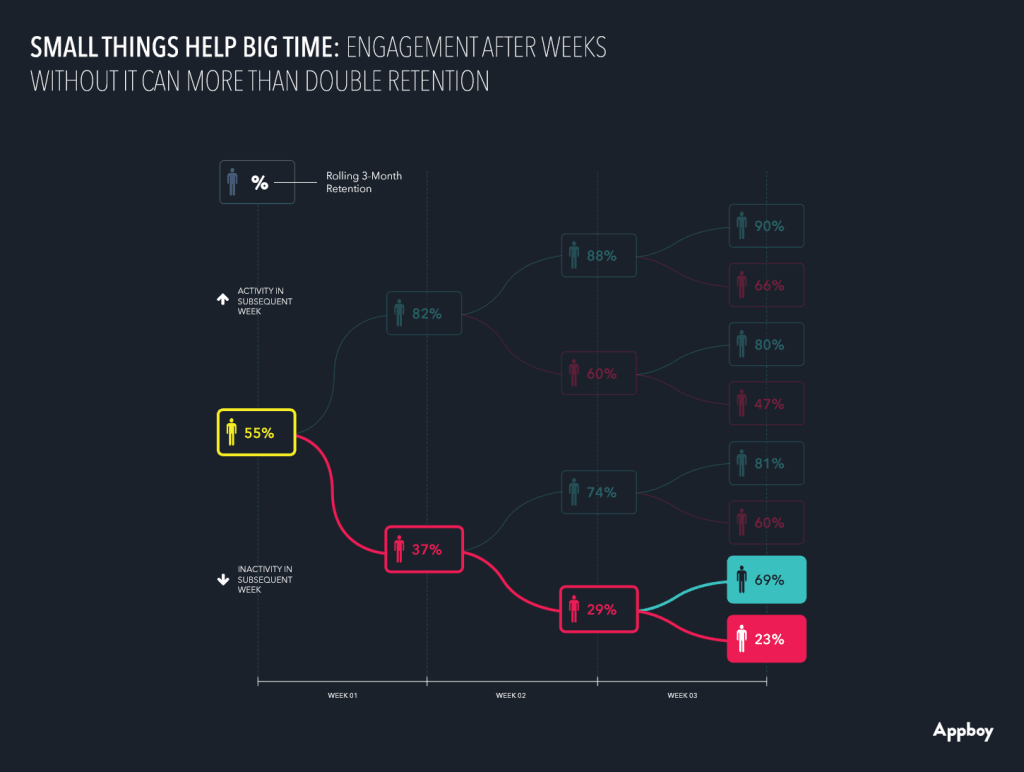
Our research found that even one instance of engagement has a significant positive impact on retention rates. While customers who fail to engage in weeks two and three have a retention rate of only 29%, if they engage during week four, their retention rate more than doubles, rising to 69%. Think of it like exercise. When someone who normally goes running every morning takes a day off, it makes it easier to take the next day off, too. But when they do start running again, they’re taking a step toward reestablishing their old daily ritual, increasing the chances they keep it up.
These numbers show that even customers who seem to have an established a pattern of consistent engagement could potentially stop using an app if they veer from that pattern, and that customers who haven’t engaged in the last week aren’t necessarily lost causes. In both cases, the challenge for brands is to convince customers to return to the app and begin building (or rebuilding) and sustaining a consistent pattern of use.
Retention pattern is consistent across vertical and OS
Mobile apps aren’t monolithic. They fall into different verticals–travel, retail, gaming and more–and run on a variety of different operating systems (including iOS, Android and Windows). But while our research found that the retention numbers associated with customer engagement varied when the data was broken down by OS and by vertical, the underlying pattern stayed the same.
iOS apps see the highest levels of retention across the board. Android apps tend to boast results similar to iOS apps when their customers engaged consistently, but suffered bigger dropoffs in retention when someone failed to engage.
Windows apps start out with lower retention than the other OSes (only 32% of customers who engage during the first week are retained, versus 58% for iOS and 52% for Android) and never catch up – even if a Windows app sees four weeks of consistent engagement from its customers, they have a retention rate comparable to customers using iOS or Android apps who missed a week along the way.
The divergence in retention rates among app verticals is smaller than among OSes. The strongest performing vertical, retail and commerce apps, sees a retention rate after week one engagement that was fifteen percentage points higher than the 55% retention rate for the average app. The weakest category, utility apps, has only 40% retention after one week of engagement, thirty percentage points lower than retail and commerce apps. However, among customers who engaged each week for the first four weeks, retail and commerce apps have only a 13 percentage point advantage over utility apps, suggesting that the impact of consistent engagement applies across verticals.
What does it all mean, anyway?
The customers who are the most likely to keep using an app are the ones who establish a consistent pattern of engagement. And because even small lulls in customer engagement levels can result in significantly lower retention, it’s essential for brands to create experiences and messaging campaigns that make interacting with their app consistently valuable for their audience.
Do that and you’re well on your way to establishing durable customer relationships that will serve you effectively over the long haul.
*Methodology
Over the course of the study, Appboy looked at approximately 200 apps, 100 million customers and five billion sessions drawn from Appboy customer data gathered between January and April 2015. For the purposes of this research, weeks are calculated as intervals of seven days following the date of a customer’s first session. Customers were counted as retained if they carried out further activity at some point during the three-month period following the reference week.

Be Absolutely Engaging.™
Sign up for regular updates from Braze.
Related Content
View the Blog
The new inbox reality: How iOS changes are reshaping email marketing

Aparna Prasad

Experience optimization: Turning data insights into better journeys

Team Braze

December 2025 Bonfire Marketer of the Month: Jagex’s Emma Oliver
